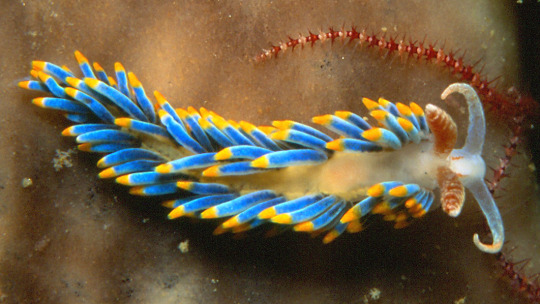Text

Nudibranchs- one of the most beautiful order of molluscs
Nudibranchs are an order of marine gastropod molluscs that are often found inhabiting coral reefs, deep sea waters, rocky sea shores and seagrass beds world wide. While they may look like fuzzy, bright gummy worms, they are real creatures.
Appearance
Nudibranchs vary in shape, size and colour, though they are very distinctive and easy to identify because of their unique appearance. Nudibranchs come in a variety of bright and often vivid colours, ranging from vibrant oranges, yellows, blues, and purples to more subdued tones. Their colour serves as a warning to predators, indicating that they are toxic and unpleasant to eat. They have soft, flexible bodies and distinctive shapes, varying from long and streamlined to bulbous and flat, depending on their species. Many nudibranch species have ornate appendages on their bodies, including cerata (finger-like projections), rhinophores (sensory organs resembling horns or antennae), and sometimes even feathery structures.
Defense, Diet and Predators
Nudibranchs have mouths that have radulas in their mouths, an organ that helps them eat. They're carnivorous, often eating sea sponges and cndarians. They steal their stinging cells (nematocysts) from their food they eat, making them toxic to predators who don't spot their bright warning colours before deciding to eat them. When attacked, toxic nudibranchs will discharge their toxins to discourage their predators from continuing.
Breeding
They're hermaphroditic, meaning they can mate with any mature gender of their kind. During mating, mates will inject sperm into each other via penis. Some species of nudibranchs will crawl out of eggs as juveniles while others come out as larvae.
Other facts
-Nudibranchs get their name from the Latin 'nudus' (naked) and Ancient Greek 'brankia' (gills), due to their exposed breathing apparatus
-Scientists are using nudibranchs for medical studies
-They're coloured that way because of the food they eat
-Their size ranges from a few centimetres to 30 centimetres long. The largest British species has been recorded at 20cm long.
-Conservation status: common
🔗Links 🔗
How nudibranchs are being studied in medicine: Frontiers | A Nudibranch Marine Extract Selectively Chemosensitizes Colorectal Cancer Cells by Inducing ROS-Mediated Endoplasmic Reticulum Stress (frontiersin.org)
Nudibranch experts and enthusiasts: nudibranchdomain.org
#marine biology#marine animals#facts#incredible#nudibranch#sea bunny#sea slug#deep sea#marine life#gastropods#molluscs#beautiful#wildlife
4 notes
·
View notes